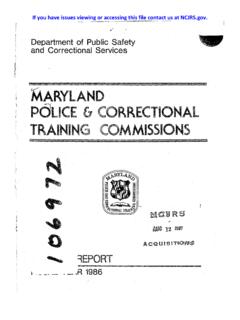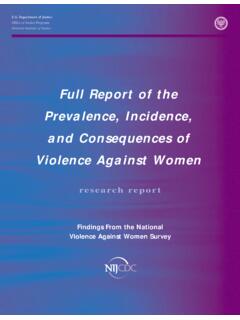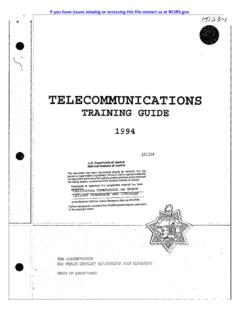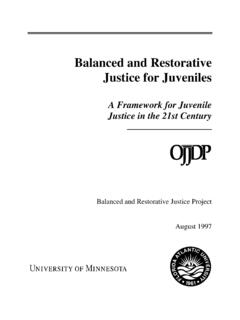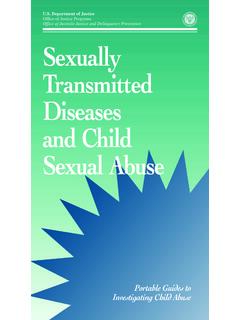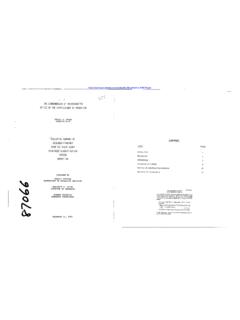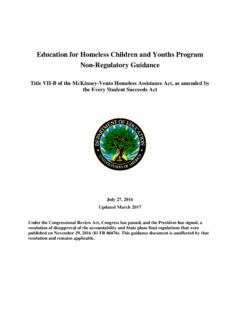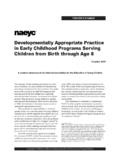Transcription of Treatment, Services, and Intervention Programs for Child ...
1 Department of Justice Office of Justice Programs Office of Juvenile Justice and Delinquency Prevention B u l l e t i n S e r i e s J. Robert Flores, Administrator March 2003. treatment , services , and Intervention Programs for Child Delinquents Youth who start offending early in childhood age 12 or younger are Barbara J. Burns, James C. Howell, Janet K. Wiig, Leena K. Augimeri, far more likely to become serious, vi- Brendan C. Welsh, Rolf Loeber, and David Petechuk olent, and chronic offenders later in life than are teenagers who begin to Sparked by high-profile cases involving Compared with juveniles who start offend during adolescence.
2 We have children who commit violent crimes, pub- offending in adolescence, Child delin- an opportunity to direct these young lic concerns regarding Child delinquents quents (age 12 and younger) are two offenders to a better path because re- have escalated. Compared with juveniles to three times more likely to become search indicates that they are at an whose delinquent behavior begins later in tomorrow's serious and violent offend- age when interventions are most like- adolescence, Child delinquents (offenders ers. This propensity, however, can be ly to succeed in diverting them from younger than age 13) face a greater risk minimized.
3 These children are poten- chronic delinquency. of becoming serious, violent, and chronic tially identifiable either before they Part of OJJDP's Child Delinquency Se- juvenile offenders. OJJDP formed the begin committing crimes or at the very ries, this Bulletin draws on findings Study Group on Very Young Offenders to early stages of criminality times when from OJJDP's Study Group on Very examine the prevalence and frequency interventions are most likely to suc- Young Offenders to assess treatment , of offending by children younger than 13. ceed. Therefore, treatment , services , services , and Intervention Programs This Study Group identified particular risk and Intervention Programs that target designed for juvenile offenders under and protective factors that are crucial to these very young offenders offer an the age of 13.
4 The Bulletin reviews developing effective early Intervention exceptional opportunity to reduce the treatment and services available to such Child delinquents and their fami- and protection Programs for very young overall level of crime in a community. lies and examines their efficacy. At a offenders. time of limited budgets, it is impera- Although much can be done to prevent tive that we consider the cost effec- This Bulletin is part of OJJDP's Child Child delinquency from escalating into tiveness of specific Programs because Delinquency Series, which presents the chronic criminality, the most successful children who are not diverted from findings of the Study Group on Very Young interventions to date have been isolat- criminal careers will require signifi- Offenders.
5 This series offers the latest ed and unintegrated with other ongoing cant resources in the future. information about Child delinquency, in- interventions . In fact, only a few well- The timely provision of the kinds cluding analyses of Child delinquency sta- organized, integrated Programs designed of treatment , services , and interven- tistics, insights into the origins of very to reduce Child delinquency exist in tion Programs described in this young offending, and descriptions of early North America today. Bulletin while Child delinquents are Intervention Programs and approaches still young and impressionable may that work to prevent the development of The Study Group on Very Young Offend- prevent their progression to chronic delinquent behavior by focusing on risk ers (the Study Group), a group of 39.
6 Criminality, saving the expense of and protective factors. experts on Child delinquency and Child later interventions . Access OJJDP publications online at psychopathology convened by the Of- particular interventions . (The Study Focusing on children with conduct dis- fice of Juvenile Justice and Delinquency Group's findings concerning risk factors order or who exhibit conduct disorder Prevention (OJJDP), has concluded that for Child delinquency will be discussed symptoms helps researchers target juveniles who commit serious and vio- more fully in another Bulletin.)
7 The both children who commit delinquent lent offenses most often have shown Study Group reviewed how the mental acts but have not been detected and persistent disruptive behavior in early health, education, Child welfare, and children at risk of committing such acts. childhood and committed minor delin- juvenile justice sectors meet the service quent acts when quite young. There- needs of children with conduct disorder This Bulletin also discusses juvenile jus- fore, comprehensive Intervention or who exhibit conduct disorder symp- tice system Programs and strategies for Programs should encompass children Although not all children with very young offenders.
8 Four promising who persistently behave in disruptive conduct disorder are technically Child Programs the Michigan Early Offender ways and Child delinquents, in addition delinquents, the behavior and problems Program, the Minnesota Delinquents to young juvenile offenders who have of acting out associated with the disor- Under 10 Program, the Sacramento committed serious and violent crimes. der are often delinquent in nature. County Community Intervention Pro- Focusing on children who persistently gram, and the Toronto Under 12 Out- behave disruptively and Child delin- reach Project that organize inter- 1.
9 According to the Diagnostic and Statistical Manual of quents has the following advantages: ventions for Child delinquents are Mental Disorders IV (DSM IV) (American Psychiatric Association, 1994), conduct disorder symptoms in- reviewed. In addition, the Bulletin out- If early interventions are success- clude aggression toward people and animals, destruc- lines a model for comprehensive inter- ful, both groups are less likely to be- tion of property, deceitfulness or theft, and serious ventions and examines the Canadian come chronically delinquent if they violations of rules.
10 Juveniles who exhibit conduct disorder symptoms are also prone to certain other approach to Child delinquency, which are exposed to additional risk fac- conditions, such as attention deficit/hyperactivity may serve as a guide for prevention tors that typically emerge during disorder (ADHD), internalizing disorders (anxiety and efforts in the United States and Europe. adolescence. depression), and substance abuse (Angold, Costello, and Erkanli, 1999). If early interventions are successful, both groups are less likely to suffer from the many negative social and Child Delinquency Research: An Overview personal consequences of persistent misbehavior.
